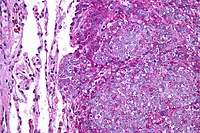
Photo from wikipedia
Osteosarcoma (OST) and Ewing sarcoma (ES) are the most common pediatric bone cancers. Patients with metastatic disease at diagnosis have poorer outcomes compared with localized disease. Using the Surveillance, Epidemiology,… Click to show full abstract
Osteosarcoma (OST) and Ewing sarcoma (ES) are the most common pediatric bone cancers. Patients with metastatic disease at diagnosis have poorer outcomes compared with localized disease. Using the Surveillance, Epidemiology, and End Results registries, we identified children and adolescents diagnosed with OST or ES between 2004 and 2015. We examined whether demographic and socioeconomic disparities were associated with a higher likelihood of metastatic disease at diagnosis and poor survival outcomes. In OST, Hispanic patients and those living in areas of high language isolation were more likely to have metastatic disease at diagnosis. Regardless of metastatic status, OST patients with public insurance had increased odds of death compared to those with private insurance. Living in counties with lower education levels increased odds of death for adolescents with metastatic disease. In ES, non-White adolescents had higher odds of death compared with white patients. Adolescents with metastatic ES living in higher poverty areas had increased odds of death compared with those living in less impoverished areas. Disparities in both diagnostic and survival outcomes based on race, ethnicity, and socioeconomic factors exist in pediatric bone cancers, potentially due to barriers to care and treatment inequities.
Journal Title: Journal of Pediatric Hematology/Oncology
Year Published: 2022
Link to full text (if available)
Share on Social Media: Sign Up to like & get
recommendations!